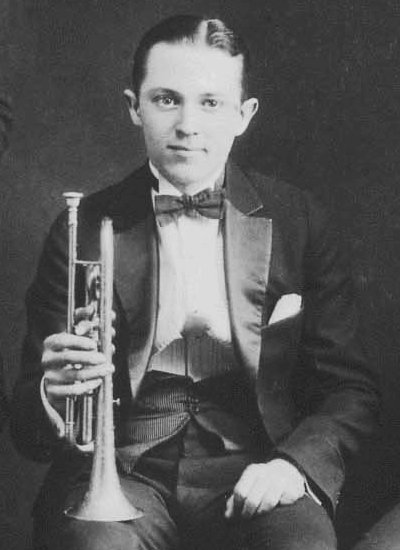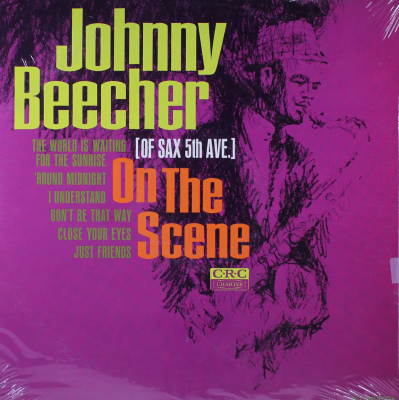.
.

Bix Beiderbecke, 1924
.
___
.
Like a Girl Saying Yes: The Sound of Bix
by Malcolm McCollum
.
…..The first time Benny Goodman heard Bix Beiderbecke play cornet, he recalled, he wondered, “My God, what planet, what galaxy, did this guy come from?” (Skretvedt)
…..Listening to him throughout my life, I’ve had the same feeling. So did hundreds of musicians who heard Bix during his short lifetime, and so have thousands of listeners since. What was it about this musician that captivated and astonished so many for so long – that still does?
…..Sax player-writer Benny Green offered one explanation: “When a musician hears Bix’s solo on ‘Singing the Blues’, he becomes aware after two bars that the soloist knows exactly what he is doing and that he has an exquisite sense of discord and resolution. He knows also that this player is endowed with the rarest jazz gift of all, a sense of form which lends to an improvised performance a coherence which no amount of teaching can produce” (Green, 105).
…..Esten Spurrier, an early bandmate of Bix’s, expands on Green’s “sense of form” remark:
“Louis [Armstrong] departed greatly from all cornet players. His ability to compose a close-knit individual 32 measures with all phrases compatible with each other to produce his own complete chorus based on the fundamental tune and chord structure of the tune played – Wow! What a screwy description. At any rate, Louis evoked envy and amazement in all of us, So Bix and I always credited Louis with being the father of the correlated chorus: play 2 measures, then 2 related, and you had 4 measures upon which you played another 4 measures related to the first 4, and so on ad infinitum to the end of the chorus. The secret became as simple as a series of related phrases, melodic phrases.” (Evans & Evans, 156).
…..Screwy or not, that’s a pretty fair description of both Louis’ and Bix’s approach to their solo flights, and certainly one of the delights of listening to Bix – that sense of an architectural drawing rising before you, full of Escheresque surprises and abrupt turns but always, when it concludes, a space of its own, self-contained yet with open windows and doorways giving the other soloists freedom to move on to their own rooms, their own constructions. But I don’t believe it was Bix’s sense of melodic form that primarily captured people’s hearts.
…..A sense of form wasn’t what Hoagy Carmichael was talking about when he wrote, “It was Bix’s four notes on a break that sent me reeling onto a couch. I was so excited by Bix’s playing . . . ” (Evans & Evans, 147). He was talking about Bix’s sound, an aspect of jazz musicians’ performance that most consider vital, even though most have a hard time talking about how it’s made, or made individual, different from the generic or “ideal” sound of a particular instrument.
…..Because we’re so visually dominated, our language doesn’t offer many words that describe the qualities of a sound. So when we try to say how one voice differs from another, we’re usually reduced to similes or metaphors. Eddie Condon describes Bix’s cornet sound as “like a girl saying yes.” Other use words like “fat,” “round,” “full,” “mellow,” or “sweet” to describe it – essentially visual or tactile metaphors. Or “pure” – describing Bix’s contribution to a Paul Whiteman performance of the 1812 Overture, Louis Armstrong wrote, “. . . . through all those different effects that were going on at the ending you could still hear Bix . . . well, you take a man with a pure tone like Bix’s and no matter how loud the other fellows may be blowing, that pure cornet or trumpet tone will cut through it all . . . ” (Hentoff&Shapiro, 158-159). Hoagy Carmichael, seldom at a loss for words, was finally forced to conclude, “His music affected me in a different way. Can’t tell you how – like licorice, you have to eat some” (Hentoff&Shapiro, 142).
…..Surely Bix’s preferred instrument – a Conn Victor cornet with an extraordinarily large bore size – and his chosen mouthpiece, deeper than most (Cullum) had something to do with that sound, but he recorded on other instruments, including trumpets, and the sound is always there, indubitably his. So it’s not merely a matter of his vehicle.
…..Ralph Berton, who got to spend a lot of time with Bix during the period when Berton’s brother Vic played and recorded with him, provides a most complete and accurate description of Bix’s sound in his memoir Remembering Bix: “Bix’s crystalllne purity of tone and precision of attack – his accent; the wit is in his dynamics, the sure delicate balance of loud & soft within the single melodic sentence; the melancholy, the all-too-accurate foreboding of early death, are in the bittersweet beauty of his melodic invention, the startling harmonic implications, the casual, almost negligent tenderness of his phrasing, the subtle diminuendo that ended each individual tone . . . ” (Berton, 401). It’s a description that bears examination.
…..One of Beiderbecke’s early inspirations came from listening to Louis Armstrong’s trumpet, wafting through the night from the Streckfus excursion boats on the Mississippi River. Music over water in the open air has a certain reverberation that even the finest concert hall doesn’t provide, and I think it’s that reverberation that Bix heard ever after and put into his playing, and that accounts for “the subtle diminuendo that ended each individual tone.”
…..Another thing that accounts for that subtle diminuendo is Bix’s lifelong exposure to classical music, in which time values are precisely kept – each quarter note lasts exactly as many parts of a second as the previous and the next quarter note. This is not the case in much jazz playing, where duration is extended or compressed constantly for expressive purposes, just as pitch is bent up or down. But it is the case in Bix’s playing: a quarter note lasts precisely one quarter of the measure, its fading volume ending only when the next note begins. So with each eighth, sixteenth or half note, They’re all given their due.
…..But I think the most important contributor to Bix’s tone was the power supporting his air column and his control over it. Bix was a gifted natural athlete. Even after he’d wholeheartedly embraced the self-destructive “Roaring 20s” way of life, he could crawl out of a gin-soaked stupor and handily crush a younger opponent on the tennis court, 6-love, or pitch a winning baseball game in which he also drove in the winning runs (Berton, 183, 293; Evans & Evans, 68). The athlete’s physical self-awareness is what I hear in Bix’s sound, a complete control over every part of the body involved in producing a sound through an instrument. Such control is partly the product of genetic gifts, partly of endless hours of practice. (Many contemporaries observed that if Bix wasn’t running chord progressions on a piano, he was running various licks on his horn pretty much every waking minute if someone didn’t interrupt him.)
…..The popular image of Bix Beiderbecke – the tortured “young man with a horn,” condemned by financial necessity to abandon pure jazz and fall into the elephantine embrace of the Whiteman Orchestra, this driving him to drink and early death – is, I think, a load of crap. There’s plenty of evidence, much of it from Bix’s own pen, that he felt both challenged and fulfilled playing with Whiteman.
…..Yet there’s no doubt, even if there are occasional doubters, that he drank himself to death, and that he was perennially dissatisfied with the music he made. The drinking was, initially, simply a part of the culture of the 20s, and if became for him a disease, well – it does for some and not for others, and no one really knows why. For Bix, part of his eventual problem may have been caused by his inborn physical strength. He could drink all night, night after night and yet continue to function. For a while. No one ever saw him staggering, heard him slurring, until toward the very end.
…..His dissatisfaction – with a body of work that, just on the evidence of his recordings, was sublimely beautiful and unique in multiple ways – can be explained, again, by the culture of the 20s. Bix’s entire approach to music, as expressed on the cornet, was Mozartian, “classical” in its gift for melodic construction, its restraint in decoration, its dynamic subtlety. But in the 20s, the world of classical music disdained and regularly disparaged jazz, and in addition had little use for Mozart or other classicists. The old warhorses of the middle and late Romantics dominated concert hall fare, and the impressionists and modernists Bix admired and hoped to emulate in his compositions for piano – such as Cyril Scott or Eastwood Lane – were mainly intent on expanding harmonic possibilities through endless experiments in chromaticism, many of which dissolved any sense of form in a maundering stew of modulations. Bix’s masterful improvisations on cornet would never be recognized as serious music by the music establishment of his day, and, sadly, Bix evidently accepted their assessment.
…..Perhaps he felt somewhat like a later improvisational master, tenor saxophonist Johnny Griffin, who told a radio interviewer, “I did something terribly wrong on another planet, and I was sent here for my sins, and I don’t know if I’m ever going to get off.” But perhaps, instead, he felt more like the Chet Baker Dave Hickey imagined: “In fact, Baker’s life was in no sense a tragic one, nor was his talent wasted or unappreciated. Given the opportunity, I’m sure that he would say of himself, as he said of Charlie Parker: ‘He had a very happy life.’” (Hickey, 80)
…..Whatever his self-doubts and disappointments, Bix Beiderbecke in his very short life left a recorded legacy that any musician could look back on with pride and satisfaction. In the apartment building where he spent his final days and nights, an old man who lived on the floor above Bix’s ran into him in the elevator one time. He asked Bix if he was the one playing the trumpet at four in the morning, and Bix began trying to apologize. The old man stopped him and begged him to keep at it; he said it was the sweetest sound he’d ever heard (Berton, 7).
.
And that sound is still available, reproduced most beautifully on Bix Beiderbeck: The Ultimate Collection, PlatCD 480, manufactured by the Prism Leisure Corporation in England. If you’ve already jettisoned your CD player, Youtube offers a wealth of reproductions of Bix’s work. Here are a few:
.
“Singin’ the Blues”
.
“Royal Garden Blues”
.
“Goose Pimples”
.
.
___
.
.
Works Cited:
Berton, Ralph, Remembering Bix, Harper&Row, 1974
Cullum, Jim Jr. : Bix Beiderbecke, http://atjs.org/Bixbeiderbecke.html
Evans, Philip R. and Linda K. , Bix/The Leon Bix Beiderbecke Story, Prelike Press, 1998
Green, Benny, The Reluctant Art: Five Studies in the Growth of Jazz, Da Capo, 1962, 1991
Hentoff, Nat & Shapiro, Nat, Hear Me Talkin’ to Ya, Rinehart, 1953
Hickey, Dave, Air Guitar, Art Issues Press, 1997
Skretvedt, Randy, notes to Bix Restored, Volumes I-III, Origin Jazz Library, PMB #333,
Sudhalter, Richard M., Lost Chords, Oxford UP, 1999
.
.
___
.
.

Malcolm McCollum taught English literature and composition, humanities and music history for 35 years at Colorado colleges and universities. He has published Dmitri’s Agenda, The Guards, Translations from the Human (with Zigmund Steiner) (poetry), My Checkered Career and The Aim Was Song (memoirs), Can You Hear Me Now? and A Loose Canon (essays on media and literacy and favorite writers)
.
.
___
.
.
Click here for information about how to submit your work
Click here to read The Sunday Poem
Click here to read “A Collection of Jazz Poetry – Spring/Summer, 2024 Edition”
Click here to subscribe to the (free) Jerry Jazz Musician quarterly newsletter
Click here to help support the ongoing publication of Jerry Jazz Musician, and to keep it commercial-free (thank you!)
.
___
.
.
Jerry Jazz Musician…human produced (and AI-free) since 1999
.
.
.

































